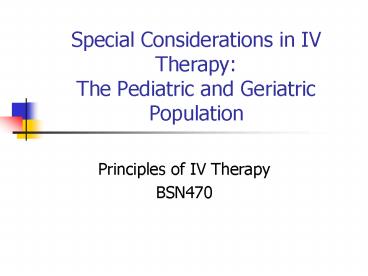Special Considerations in IV Therapy: The Pediatric and Geriatric Population - PowerPoint PPT Presentation
1 / 20
Title:
Special Considerations in IV Therapy: The Pediatric and Geriatric Population
Description:
Special Considerations in IV Therapy: The Pediatric and Geriatric Population Principles of IV Therapy BSN470 Pediatric IV Therapy Neonate: Extra uterine life up to ... – PowerPoint PPT presentation
Number of Views:285
Avg rating:3.0/5.0
Title: Special Considerations in IV Therapy: The Pediatric and Geriatric Population
1
Special Considerations in IV Therapy The
Pediatric and GeriatricPopulation
- Principles of IV Therapy
- BSN470
2
Pediatric IV Therapy
- Neonate Extra uterine life up to the first 28
days. Low-birth-weight and premature infants have
decreased energy stores and increased metabolic
needs compared with those of full-term and
average-weight newborns.
3
Pediatric IV Therapy (cont)
- Premature Infant body made up of approximately
90 water - Newborn Infant body made up of 70-80 water
- Adult is about 60
- Infants have proportionately more water in the
extracellular compartment than do adults
4
Pediatric IV Therapy (cont)
- Infants are more vulnerable to fluid volume
deficit because the ingest and excrete a
relatively greater daily volume of water than
adults. - Any condition that interferes with normal water
and electrolyte intake or that produces excessive
water and electrolyte losses will produce a more
rapid depletion of water and electrolyte stores.
5
Pediatric IV Therapy (cont)
- Illness, increases muscular activity, thermal
stress, congenital abnormalities, and respiratory
distress syndrome influence metabolic demands - Metabolic demand of infant is 2 times higher per
unit of weight than that of an adult. - For high-risk infants, calorie requirement is up
to 100 higher than normal newborn
6
Pediatric IV Therapy (cont)
- Immature homeostatic regulating mechanisms
- Renal function, acid-base balance, body surface
area differences, and electrolyte concentrations
must be taken into consideration when planning
fluid needs - Renal function not completely developed Kidneys
have limited concentrating ability and require
more water to excrete a given amount of solutes.
7
Pediatric IV Therapy (cont)
- Integumentary system in neonates important route
of fluid loss - Gastrointestinal membranes are an extension of
the body surface area, greater losses occur from
the GI tract in sick infants - Plasma electrolyte concentrations do not vary
strikingly among infants, small children, and
adults.
8
Pediatric IV Therapy (cont)
- Candidates for Neonatal IV Fluids
- Congenital cardiac disorders
- GI defects
- Neurologic defects
- Candidates for Infant IV Fluids
- Dehydration (FVD)
- Diarrhea(Electrolyte imbalance
- Antibiotic therapy
- Nutritional support
- Antineoplastic therapy
9
Components of the Pediatric Physical Assessment
- Measurement of the head circumference (up to 1
year) - Height or length
- Weight
- Vital Signs
- Skin Turgor
- Presence of tears
- Mucous membranes
- Urinary output
- Fontnaelles
- Level of acitivity
10
Assessment of Fluid Needs
- Meter Square Method (body surface area)
- Nomogram used
- Weight Method
- 100-150mL/kg to estimate fluid requirements
- Caloric Method
- Calculates the usual metabolic expenditure of
fluid
11
Site Selection
- Age of Child
- Size of Child
- Condition of vein
- Reason for therapy
- General patient condition
- Mobility and level of activity
- Gross and fine motor skills
- Sense of body image
- Fear of mutilation
- Cognitive ability of the child
12
(No Transcript)
13
Selecting Equipment
- Electronic infusion device
- Solution container with a volume based on the
age, height and weight containing no more than
500ml perferably 250m/L - Volume control chamber
- Plastic fluid container
- Microdrip tubing
- Visible cannula site
- 0.2 micron air eliminating filter set
14
Medication Administration
- Intermittent Infusion
- Retrograde Infusion
- Syringe Pump
- Alternaitve Administration Routes
- Intraosseous Route
- Umbilical Vein and Arteries
15
Geriatric IV Therapy
- Loss of cells and loss of physiologic reserve
make up the dominant processes of aging - Major Changes
- Homeostatic changes
- Immune system
- Cardiovascular changes
- Skin and Connective tissue changes
16
Geriatric IV Therapy (Cont)
- Older persons do not possess the fluid reserves
of younger individuals - Less ability to adapt readily to rapid changes
- Renal changes decreased glomerular filtration
rate - Total body water reduced by 6
- Cardiovascular and respiratory changes combine to
contribute to a slower response to blood loss,
fluid depletion, shock, and acid-base imbalances
17
Assessment Guidelines for the Geriatric Patient
- Skin turgor forehead or sternum
- Temperature
- Rate and Filling of veins in had or foot
- Daily weight
- Intake and output
- Tongue
- Orthostatic
- Swallowing ability
- Functional assessment
18
Tips for Fragile Veins
- To prevent hematoma, avoid overdistention
- Avoid multiple tapping of the vein
- Use the smallest gauge needle necessary
- Lower the angle of approach
- Pull the skin taut and stabilize the vein
- Use the one handed technique
19
Other Special Problems
- Alterations in Skin Surfaces
- Hard Sclerosed Vessels
- Obesity
- Edema
20
(No Transcript)

